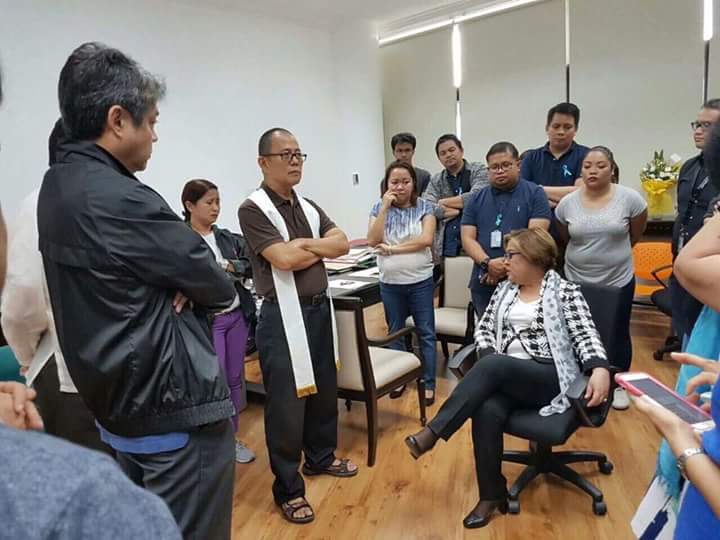
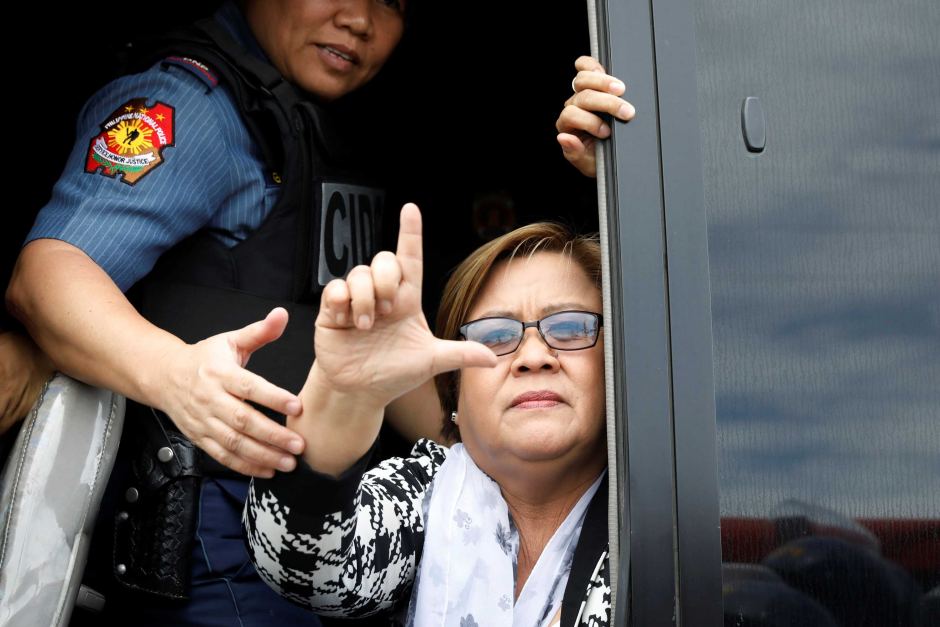

"Naka upo lang si madame, enduring everything, dignity in silence. Itong si Leila kulang na lang bumuga ng apoy."
Overseas Filipino Worker's - The Philippine Economy Army




"Naka upo lang si madame, enduring everything, dignity in silence. Itong si Leila kulang na lang bumuga ng apoy."
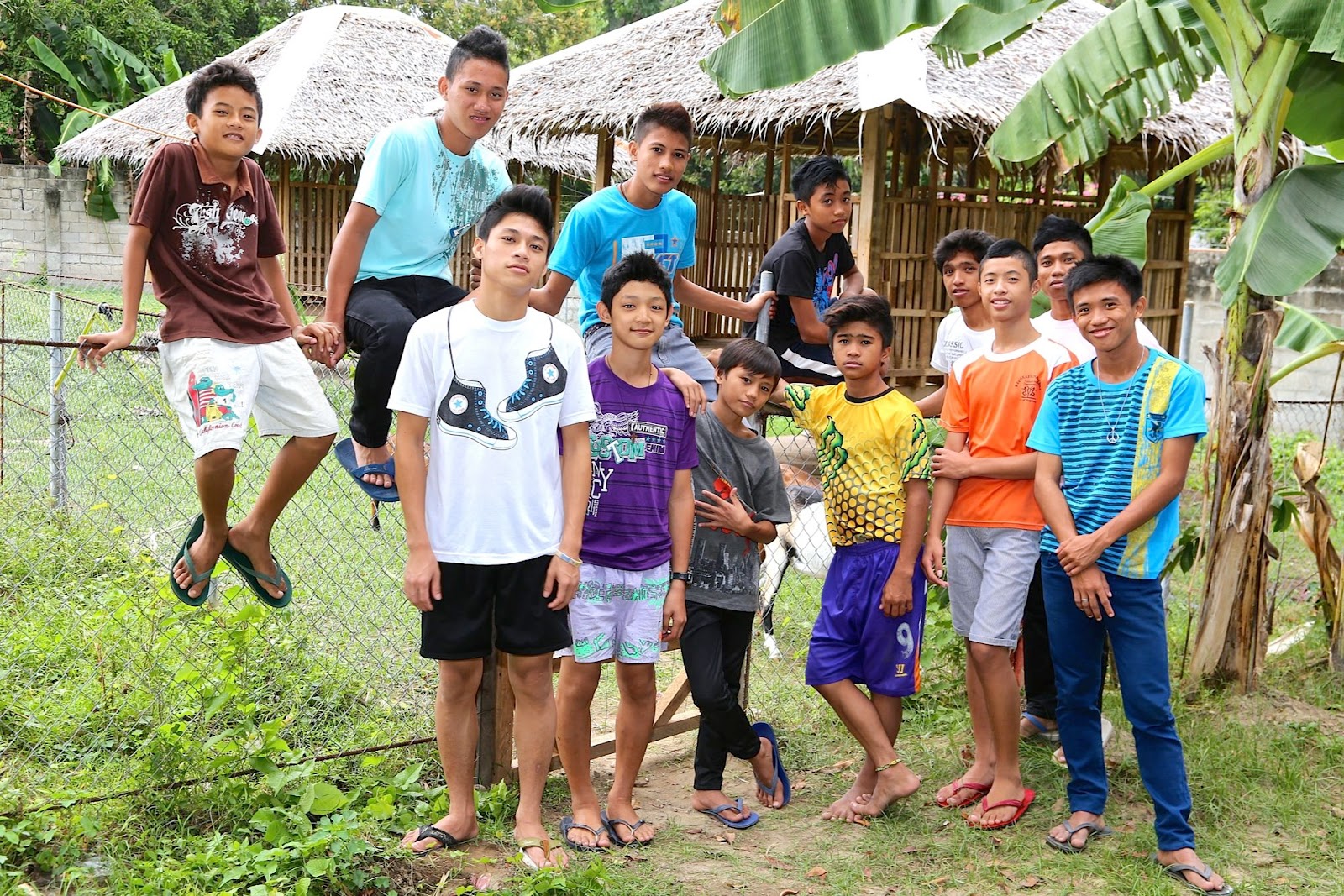
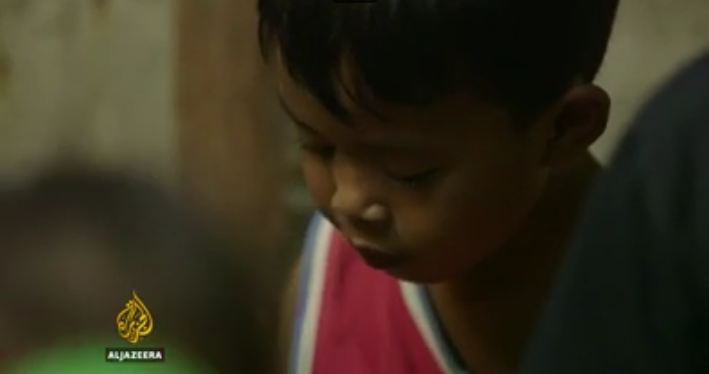

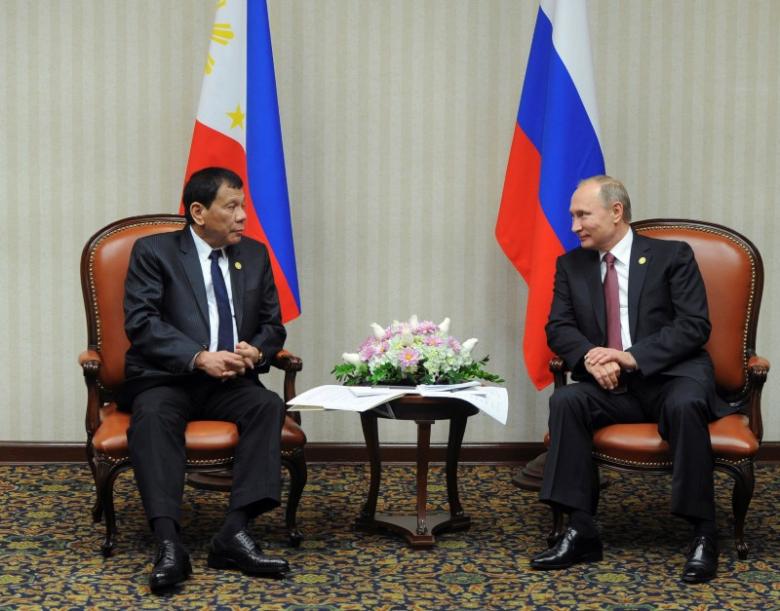


RECORD-HIGH TRUST RATING. President Rodrigo Duterte is trusted by nearly all Filipinos as he begins his term. Photo by King Rodriguez/PPD
Duterte enjoys record-high 91% trust rating – Pulse Asia
MANILA, Philippines: Nearly all Filipinos trust President Rodrigo Duterte as he embarked on his term, according to the results of a Pulse Asia Research, Incorporated survey released on Wednesday, July 20.
The results of the nationwide survey conducted among 1,200 Filipinos from July 2 to 8, showed that 91% of Filipinos trust Duterte, while less than half a percent distrust him, and 8% are undecided on whether or not to trust him.
“President Rodrigo R. Duterte begins his stint as the country’s 16th president with an overwhelming majority of his constituents expressing trust in him (91%) and practically no one distrusting him (0.2%). The rest of Filipinos (8%) cannot say if they trust or distrust President Duterte,” Pulse Asia president Ronald Holmes said.
Former president Benigno Aquino III used to hold the record of the highest level of public trust in the Pulse Asia trust survey first conducted in 1999. In a survey held during a similar period in Aquino's term – July 1 to 11, 2010 – Aquino had a trust rating of 85%.

Data from Pulse Asia Research, Inc
Among geographical locations, Duterte earned the highest trust rating in his bailiwick, Mindanao (97%). Among socioeconomic classes, trust for Duterte is highest among Class D and the poorest Class D, both at 92%.
In a statement, Palace Communications Secretary Martin Andanar said Duterte’s 91%-trust rating during his first week in office “is a humbling reminder that the genuine and meaningful change that our people aspire for is now being felt.”
“This expression of confidence, therefore, shall serve as an inspiration to the Duterte administration to continuously make a real difference and make our people’s lives better, safer, and healthier,” Andanar said.
A Pulse Asia survey conducted in early July also shows that a 'sizeable majority' of Filipinos trust Vice President Leni Robredo
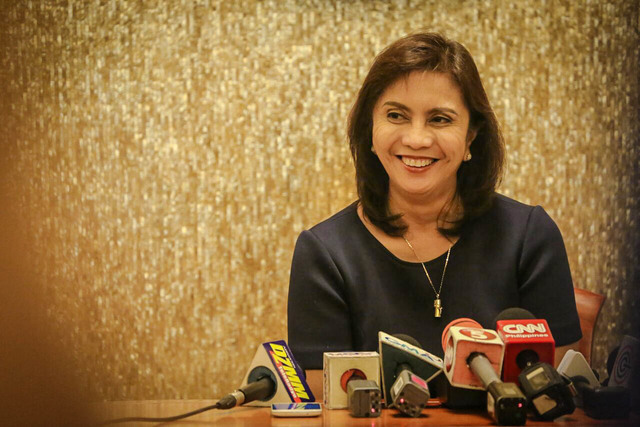
SIZEABLE MAJORITY TRUST. Vice President Leni Robredo enjoys a 62% trust rating in the July 2016 Pulse Asia survey. RAPPLER.com
The survey results also showed that 62% of Filipinos – a “sizeable majority,” according to Holmes – trust the Vice President, while 11% distrust her, and 27% are undecided on whether or not to trust her.
“Most Filipinos – regardless of geographic location and socioeconomic status – say they trust Vice-President Robredo (58% to 72% and 53% to 64%, respectively),” Holmes said.
Among geographical areas, Robredo got her highest trust rating from the Visayas (72%), and among socioeconomic classes, from Class D (64%). Indecision on whether to trust the Vice President is highest in Mindanao (32%) and among the well-off class ABC (35%).
Robredo thanked her countrymen for the overwhelming "vote of confidence."
"We are overwhelmed by the outpouring of support from our fellow Filipinos. From 1% in the pre-election surveys to 35.1% – and now, a trust rating of 62%," she said in a statement.
The survey showed that the primary sentiment toward the Chief Justice is one of indecision, as 42% of Filipinos are undecided on whether or not to trust her. But there are more Filipinos who trust Sereno than distrust her (35% vs 19%).
“Big plurality indecision figures are posted by the Supreme Court Chief Justice in the Visayas (43%) and Class E (46%). On the other hand, the latter receives practically the same trust and indecision ratings in Metro Manila (40% versus 37%), the rest of Luzon (36% versus 46%), Mindanao (38% versus 36%), Class ABC (37% versus 50%), and Class D (38% versus 39%),” Holmes said.
During and immediately before the survey period, among the major news were the oath-taking of Duterte and Robredo, Cabinet appointments including Robredo as housing chief, cases filed against Aquino in connection with the Disbursement Acceleration Program and the Mamasapano clash, and the spate of drug-related killings in the country and calls to probe these.
Around this time, Duterte also expressed his willingness to have bilateral talks and joint exploration with China in the West Philippine Sea (South China Sea), Holmes said.
The nationwide survey has a ± 3% error margin at the 95% confidence level; subnational estimates for each of the geographic areas covered in the survey (i.e., Metro Manila, the rest of Luzon, Visayas and Mindanao) have a ± 6% error margin, also at 95% confidence level.
The July survey also polled the respondents on their expectations of the new administration. (READ: Inflation, jobs edge out crime as Filipinos' top worries – poll) – Rappler.com
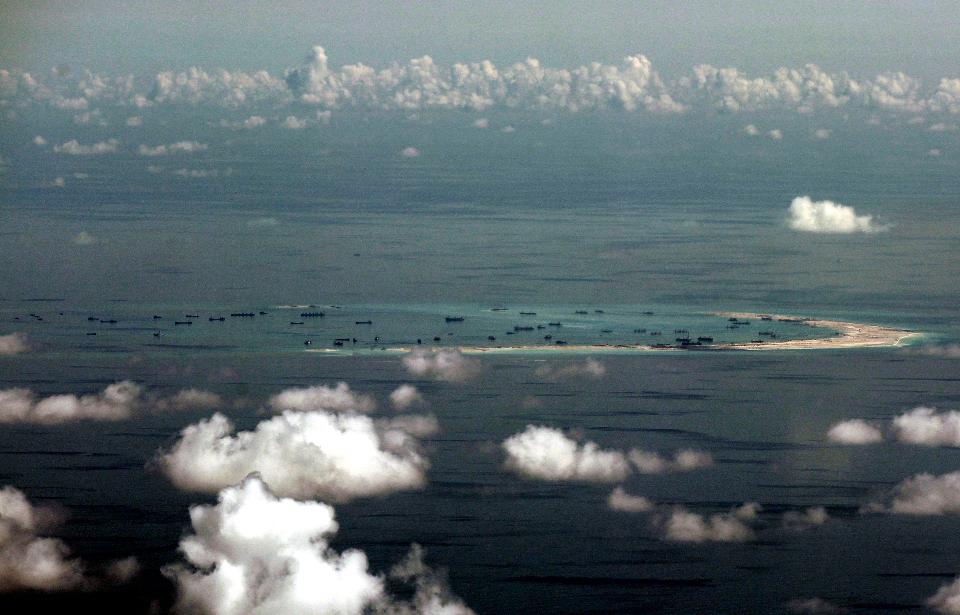
This Monday, May 11, 2015, file photo, taken through a glass window of a military plane, shows China’s alleged on-going reclamation of Mischief Reef in the Spratly Islands in the South China Sea. China’s campaign of island building in the South China Sea might soon quadruple the number of airstrips available to the People’s Liberation Army in the highly contested, environmentally delicate, and strategically vital region. (Ritchie B. Tongo/Pool Photo via AP, File)
The Philippines Should Sue China For $177 Billion In South China Sea Rent And Damages
China owes the Philippines and other countries more than $177 billion in rent and damages for China’s South China Sea fiasco. The Permanent Court of Arbitration found on Tuesday that Mischief Reef is a low-water elevation and within Philippines’ exclusive economic zone. This gives the Philippines’ indisputable legal rights to the reef. But since 1995 when China occupied the reef, China irreparably harmed the reef’s delicate marine ecosystem by dredging and building an artificial island there, including a military garrison and air-strip. By my estimate, China owes the Philippines $12.4 billion in rent and damages for Mischief Reef alone. Considering other Chinese island-building, the country owes the Philippines and other claimant countries more than $177 billion. If China doesn’t want to pay, the Philippines can sue in the courts of the U.S. and other countries where China holds property.
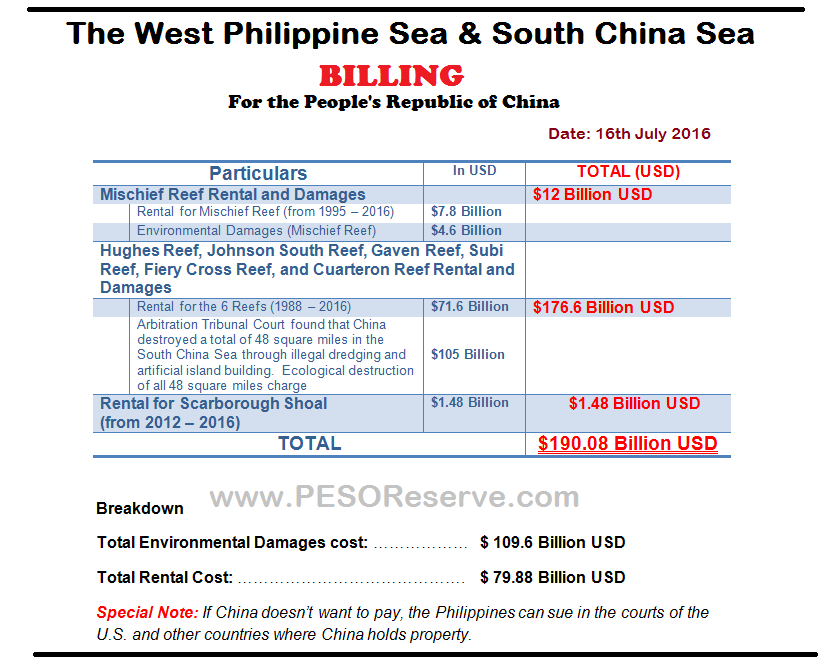
Billing Computation is a separate computation provided by the PesoReserve.com
Here is how to calculate what China owes. In 2015, the U.S. paid $1.97 million to the Philippines for 0.58 acres of coral reef destroyed when the USS Guardian went aground. That is a key reference point for environmental claims. Rent is even more costly. In 1988, the Philippines demanded $1.2 billion from the U.S. in rent for 6 military bases — $200 million each per year in 1988 dollars. The U.S. refused and got evicted.
By those metrics, the Philippines could sue China for about $4.6 billion of environmental damages to Mischief Reef in 2016 dollars, plus the requirement to pay $7.8 billion in rent. If China refuses to pay the combined $12.4 billion, the Philippines could seek redress in foreign civil courts to attach China’s offshore assets — of which there are plenty.
But China is liable for much more. China occupied six additional features in 1988 in the Spratley’s claimed by the Philippines, plus Scarborough Shoal in 2012.
The Philippines did not resist because they justifiably feared violence on the part of China. In 1988, Vietnam claims that China killed 64 Vietnamese soldiers who resisted on Johnson South Reef in the Spratley’s. China disputes the claim, but according to historian and BBC reporter Bill Hayton, “Strangely, a propaganda film released by the Chinese Navy in 2009 to celebrate the navy’s 60th anniversary gives more credence to the Vietnamese version. The video, now available on YouTube, was shot from one of the Chinese ships and shows the Vietnamese force standing knee deep in water as the tide rises over the reef. Huge spouts of water then erupt around the Vietnamese troops as the Chinese ships open fire. Within seconds the thin line of men has completely disappeared and 64 lie dead in the water: the machine guns are Chinese and the victims Vietnamese. The Chinese won the battle of Johnson Reef with a turkey shoot.”
China occupied six features within Philippines’ claim in 1988: Hughes Reef, Johnson South Reef, Gaven Reef, Subi Reef, Fiery Cross Reef, and Cuarteron Reef. China has since dredged and built on all these reefs. Based on Philippines’ 1988 demand for rent from the U.S., each of these six features should yield (in 2016 dollars) about $10.3 billion for 29 years of use — a total of $62 billion.
China occupied Scarborough Shoal in 2012, but has not yet built there. There are no known environmental damages to the shoal, but rent for five years should be about $1.8 billion (inclusive of 2012 and 2016).
By my count, and including the $7.8 billion in rent for Mischief Reef, China owes the Philippines about $71.6 billion in rent for occupation of all 8 China-occupied features in the Philippines’ claimed part of the South China Sea.
In addition, the Court found that China destroyed a total of 48 square miles in the South China Sea through illegal dredging and artificial island building. Based on the $1.97 million paid by the U.S. to the Philippines in 2015 for the grounding of the USS Guardian, an international court could levy a $105 billion fine on China for ecological destruction of all 48 square miles, payable to the Philippines and other claimant states.
Should China refuse to pay, the Philippines and other claimants can bring civil suits in the U.S. and any other locations where China holds substantial assets. The total levy on China for rent on Philippine-claimed features, plus ecological damage to the entire South China Sea, should be about $176.6 billion: double Philippines’ annual GDP, and about a third of China’s GDP. That doesn’t include rent payable to other claimants, which should also be paid.
When China vacates its artificial islands in the South China Sea and pays this fine, plus rent to other claimants and any additional payments to the families of those killed, most attentive citizens will consider justice to have been done. Until then the international ruling in favor of the Philippines, as China has said, is just a sheet of paper. - FORBES
CONTRIBUTOR
I worked in military intelligence for five years, including on nuclear weapons, terrorism, cyber-security, border security, and counter-insurgency. I covered and visited Asia and Europe, and worked in Afghanistan for one and a half years. I have a Ph.D. in Government from Harvard University, and a B.A. and M.A. in international relations from Yale University (Summa cum laude). My company, Corr Analytics, provides political risk analysis to commercial, non-profit, and media clients, and publishes the Journal of Political Risk. I am editing a series on the South China Sea conflict, and have covered and visited Africa, the Middle East and Latin America.
The author is a Forbes contributor. The opinions expressed are those of the writer.
I cover international politics, security and political risk.
Follow me on Twitter @anderscorr. If you have any additional information related to this article, contact me at corr@canalyt.com.

PNoy opens Iloilo Convention Center
MANILA, Philippines - President Benigno Aquino III led on Monday the inauguration of the controversial ₱700-million Iloilo Convention Center (ICC).
Aquino opened the state-of-the-art convention facility located on a 1.7-hectare lot in Iloilo Business Park, Mandurriao, Iloilo City.
The ICC became controversial last year after former provincial administrator Manuel Mejorada Jr. alleged that the structure was overpriced and implicated Senate President Franklin Drilon, an Ilonggo.
Mejorada accused Drilon of conspiring with a supposedly favored contractor to rig the bidding of the project.
Mejorada alleged that W.V. Coscoluella and Associates, which designed the building, was awarded a contract without a public bidding and that construction was overpriced by ₱488 million.
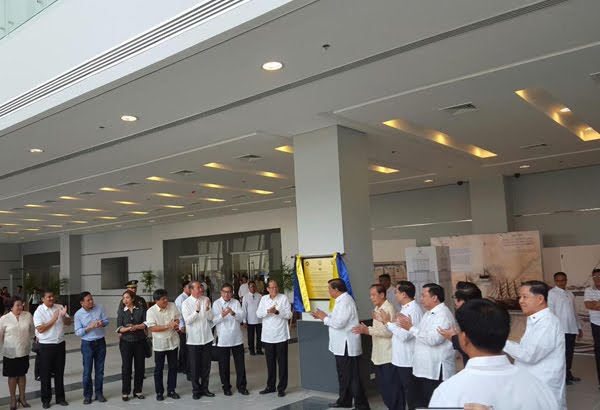
President Aquino at the inauguration of the Iloilo Convention Center in Iloilo City. Official Gazette PH
Drilon was charged with graft before the Office of the Ombudsman in October 2014, but the charge was dismissed for lack of merit.
Two stories high with a floor area of 11,832 square meters, the ICC can accommodate over 3,000 guests. It will be used as one of the venues for some high-level ministerial meetings of this year's Asia Pacific Economic Cooperation Summit.
The construction of the ICC began in 2013 and was based on a design inspired by Iloilo's Dinagyang and Paraw festivals.
Aquino also joined the ceremonial launch of the Iloilo Business Park and Richmonde Hotel Iloilo. - Louis Bacani @philSTAR
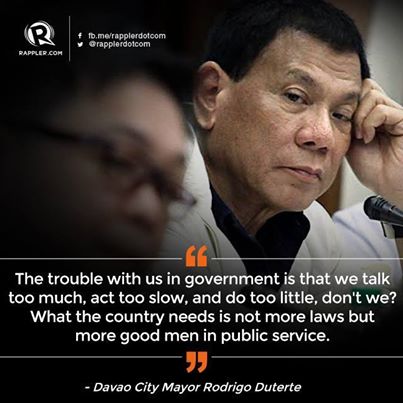
The trouble with us in government is that we talk too much, act too slow, and do too little, don't we? What the country needs is not more laws but more good men in public service. image: rappler.com
Support for Duterte presidential run gathers steam
Davao City mayor yet to commit to the idea of running for highest office
Manila: Support for a presidential bid for Davao City’s mayor, Rodrigo Duterte, is gaining ground even as the prospective candidate himself is yet to commit to the idea.
“Yes, talks are on going, but nothing is final at this time,” a source from Cebu City told Gulf News when asked to confirm reports that negotiations are going on between Duterte’s camp and that of the Nacionalista Party (NP) of former Senator Manuel Villar and the Partido Demokratiko-Lakas ng Bayan (PDP-Laban) of Senator Aquilino Pimentel III.
Duterte currently belongs to the PDP-Laban.
With their formidable machineries, the two parties together form the biggest political organisations in the country.
It was responsible for the near-win of Villar in the 2010 presidential contest. Villar tallied only second in the electoral contest, losing to current President Benigno Aquino III.
The source confided to Gulf News that NP is courting the support of Duterte as part of a political concession to Villar, whose wife, Senator Cynthia Villar is reportedly seeking the vice-presidency in the 2016 polls.
Merger
Reports said an official announcement of a merger of the PDP-Laban-Nacionalista Party is due soon.
So far, Duterte remains non-committed although there are widespread calls for him to run for the top executive office.
A no-nonsense lawyer and administrator, Duterte had been elected mayor of the country’s biggest city — Davao City, time and again despite his image as a leader who would cut short tedious judicial processes by rendering justice swiftly and without fanfare.
In 2012, he forced a man selling fake land titles to eat the counterfeit certificates the latter had been selling to hapless informal settlers.
He would, at a heartbeat, tell rice smugglers that he would have them shot to death if they continue with their nefarious ways.
But the source said, all of this is part of an image Duterte cultivated and happily basked in.
Death squads
“They say he had people executed through the so-called Davao Death Squads but up to now, no one has any proof that he was behind these killings,” said the source.
“For one thing, Mayor Duterte epitomises everything that the government should be — quick to act on concerns even outside the media glare. The people are fed up with slow moving politicians,” he said.
“If only he will run for president then things would appear a little better for a lot of people,” he added.
Mar Roxas: Real survey is in 2016
ZAMBOANGA - Local Government Secretary Mar Roxas is thankful for the results of an internal survey that showed him winning the presidency if he goes one-on-one against Vice-President Jejomar Binay.
Roxas, who arrived Thursday morning in the city, toured different radio and TV stations.
In an interview, the Liberal Party candidate said he is grateful for the results of an internal survey commissioned by the LP. The survey showed that Roxas will win if the presidential race were a one-on-one fight between him and Vice President Jejomar Binay.
Roxas said he is not privy to the details of the internal survey.
He also said the real survey will rely on the results of the 2016 election.
Before he left, Roxas made a joke that as of present he too is excited to know who will be his running mate in the 2016 elections.
Roxas is set to attend the three-day Mindanao Business Conference in Dipolog City, which formally opened yesterday. Business leaders and stakeholders from the different parts of the country are among those who participated in the activity. - Gulf news / ABS- CBN
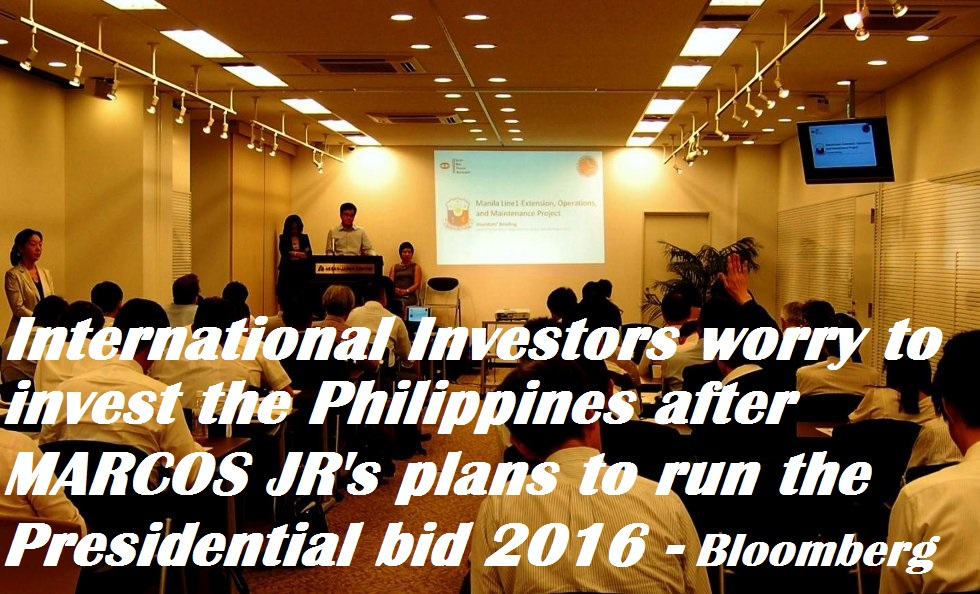
The Philippines and South Korea are the big winners from China's slowdown
How panicked were investors last week about China's stock market plunge? Enough to treat the Korean peninsula, a place that was teetering on the brink of war, as a safe haven.
Even as policy makers braced for renewed military confrontation between North and South Korea, the won staged a rally.
It may be time to start counting Korea as a developed nation, rather than an emerging market.
That's made South Korean assets one of the few bright spots in a dark time for emerging markets. On August 24 alone, investors yanked $2.7 trillion out of developing nations, with Indonesia, Malaysia and Thailand especially hard hit. It matched the violent September 2008 selloff after Lehman Brothers collapsed.
Back then, Korea was battered so hard that pundits were calling it the "next Iceland" and the "Bear Stearns economy". Now, together with the Philippines, it's one of Asia's only refuges from chaos.
It's not hard to explain why many Asian economies are suffering from China's slowdown. Exporters of commodities, who depended on a humming Chinese market, have especially suffered. But why are there such big outliers among battered emerging markets?
Less like lemmings
The answer is that investors are finally basing their decisions less on herd mentality than nuanced, case-by-case analyses.
"Emerging market investors have become a lot savvier," says economist Frederic Neumann of HSBC in Hong Kong.
"Gone are the days where emerging markets were all lumped into one bucket. Today, countries with stronger fundamentals are able to resist the spread of contagion washing over global financial markets."
Along with South Korea and the Philippines, Neumann notes that even some frontier economies, like Vietnam, "have weathered global financial turmoil with apparent ease".
The common link among the success stories is they've got the basics right since Asia's 1997 financial meltdown. They have healthier financial systems, greater transparency, stronger banks, sober national balance sheets, and reasonable current-account deficits.
Malaysia's reckoning, by contrast, is long overdue.
The ringgit is trading near 17-year lows because scandal-plagued Prime Minister Najib Razak cares more about staying in power than modernising the country's unproductive economy.
Meanwhile, Thailand's military junta is undoing much of the progress Bangkok made since the late 1990s in strengthening the rule of law. And for all its gripes that Indonesia is being unfairly lumped in with Asia's laggards, President Joko Widodo's administration is rapidly losing the trust of investors.
While there's still time to win it back, Widodo's first 315 days in office have been a case study in timidity, drift and lost opportunities.
Korea credible
Korea, by contrast, is on the "more credible side of the spectrum," says economist Marc Chandler of Brown Brothers Harriman.
Even though China's downshift and US interest rate hikes will eventually make a dent, the won was Asia's top performer last week. Its 2.7 percent gain almost matched the drop in the Chinese yuan since August 11.
Meanwhile, Korean bond yields are falling. It turns out that the world's central banks had it right last year when they boosted their Korean debt holdings. In 2014, they made up 45.4 percent of the foreign-held portion of Korea Treasury bonds, up from 41.8 percent a year earlier.
It may be time to start counting Korea as a developed nation, rather than an emerging market. Korea still faces many challenges, not least of which are its rogue family-run conglomerates. But its macroeconomic performance deserves the recognition it's receiving from investors.
The same goes for the Philippines. Since 2010, President Benigno Aquino has steadily improved his nation's debt position (winning investment-grade ratings in the process), attacked graft and drawn in waves of foreign-direct investment.
Last month, reporters asked Philippine central bank governor Amando Tetangco if he's worried about the spectre of economic crisis haunting Asia at the moment.
"There's a herd mentality," he said, "but there'll be differentiation."
So far, he's been proven right. The country formerly derided as the "sick man of Asia" has been standing its ground amid market chaos.
Still risks
Risks abound, of course. While South Korea's economic fundamentals are stable – it's growing at a rate of 2.2 percent with a 3.7 percent jobless rate – its high household debt of $458 billion is a concern.
Manila, for its part, faces an uncertain 2016 election, in which Ferdinand Marcos Jr, son of the dictator who ravaged the nation in the 1970s and 1980s, may make a bid for the presidency. History has shown that emerging markets are often just one bad leader away from relapsing into chaos.
For now, the relative stability washing over Korea and the Philippines underscores that steady leadership and long-term thinking matter. It also shows that global investors are getting better at identifying those factors in Asia. - Bloomberg / The Sydney Morning Herald
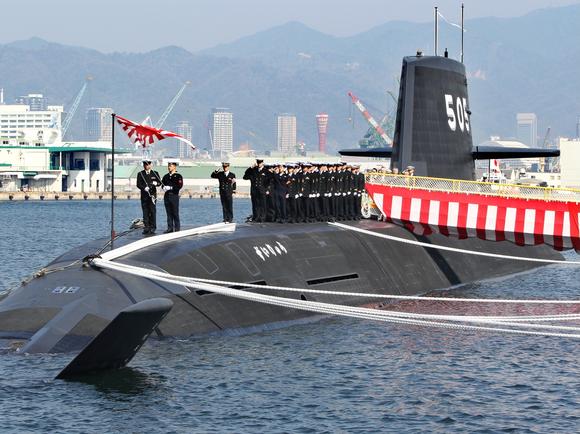
Philippines is interested in acquiring Diesel submarines based on technology from the Japan Maritime Self-Defense Force's Soryu-class vessel. image:asia.nikkei.com
Philippines to buy submarines and advanced missile systems for the first time
This will ensure strength in the South China Sea
Manila: For the first time, the Philippines will buy electric and diesel-run submarines, including advanced missile systems, as listed in its $22.11 billion (998 billion pesos or Dh83.166 billion) modernization plan that was approved in July, to ensure its strength against China, Taiwan, Vietnam, Brunei, and Malaysia which have overlapping claims in the South China Sea, sources said.
“The Philippine Navy will buy several submarines and missile systems in the next five years from private manufacturing firms either from South Korea or Japan,” a military source who requested anonymity told Gulf News.
“The ambitious purchase was scheduled after the Philippine economy grew, received good ratings from rating agencies, and allowed borrowing for expensive war materials, but the Philippines could not yet match China’s 26 submarines,” said the same source.
In 2013, the Philippine Navy bought two 1.400 tons Incheon-class frigates (also called Future Frigate experimental or FFX), manufactured by South Korea’s Hyundai Heavy Industries and STX Offshore and Shipbuilding for $400 million (18 billion pesos or Dh1.5 billion); two strategic sealift vessels or floating command centers which can transport three helicopters per vessel, soldiers, and supplies at sea, from Indonesia’s PT PAL (Persero) for $85.7 million (3.86 billion pesos or Dh321.6 million). The new frigates and sealift vessels will arrive in the Philippines at the end of 2015 or early 2016, President Benigno Aquino announced recently.
It is widely reported that the Philippine Navy is manned by three US-made refurbished frigates: BRP Tagbanua; BRP Gregorio del Pilar and BRP Ramon Alcaraz, but Japan’s defense ministry said the Philippine Navy has 80 warships; China, 892; Malaysia, 208; and Vietnam, 94.
The Philippine Coast Guard also bought 10 40-metre-long multi-purpose response vessels (MRRV) from Japan in late 2013 for $184 million (8.09 billion pesos or Dh674.6 million), in a loan forged with Japan International Cooperation Agency (JICA) in 2014. They will augment the Coast Guard’s 19 rescue vessels, when they arrive in the Philippines at the end of 2015, sources said.
The Coast Guard secured a $20 million (900 million pesos or Dh75 million) loan from the United States’ Defense Threat Reduction Agency (it has a maritime security project with the US’ Weapons for Mass Destruction Proliferation Prevention Program) for three aerial surveillance radars, two surface sensors and three surveillance planes for the Philippine Coast Guard National Coast Watch Centre in northern Luzon and southwest Philippines.
Recently, the Philippine Air Force bought 12 new FA-50 fighter-trainers made by Korea Aerospace Industries. six Close Air Support Aircraft; seven of 13 AW-109 helicopters; and six of eight Bell-412 combat utility helicopters made by Korea Aerospace Industries. The two fighters will arrive in December 2015 or early 2016, and the rest in 2017.
Japan’s defense ministry said the Philippines has a total of 26 combat aircraft, compared with China’s 2,582 combat aircraft.
The Philippine government also allotted $22 million (1 billion pesos or Dh83.33 million) for the development of three new naval bases that will protect its 36,000 kilometer coastline facing the South China Sea.
In 1995, Congress approved an $8.08 billion (364 billion pesos or Dh30.3 billion) military modernization plan for 15 years. But only 10 per cent of the approved budget was secured by a loan 15 years later, in 2010, the budget department said.
China, Taiwan, and Vietnam claim the whole of the South China Sea and several parts of the oil-rich Spratly Archipelago. Brunei, Malaysia, and the Philippines claim their respective exclusive economic zones in the South China Sea and parts of the Spratly Archipelago. - Gulf News

Philippines challenges China's Claim of country's exclusive economic zone at UNCLOS Tribunal in The Hague. image: inquirer.net
IN PHOTOS: Philippines challenges China in The Hague
In photos emailed to Rappler, the Permanent Court of Arbitration gives us a glimpse of the closed-door hearings pitting Manila against Beijing
MANILA, Philippines – Behind closed doors, the Philippines recently waged a legal battle against China in The Hague, Netherlands, in a historic case over the disputed West Philippine Sea (South China Sea).
The Philippines on Thursday, July 23, is set to submit a new document to The Hague to bolster its case.
While Manila pursues this, a question remains: What exactly happened during hearings from July 7 to 13?
The Permanent Court of Arbitration (PCA) in The Hague, which serves as the venue for the arbitration proceedings, emailed Rappler high-resolution photos to give us a glimpse of the closed-door hearings.
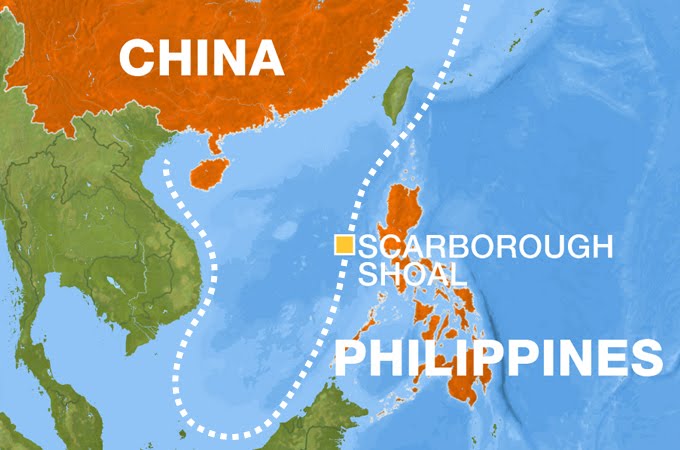
China claimed the shores of Vietnam, Philippines, Malaysia, Indonesia, Brunei and Japan as their own
The photos show a powerhouse team, led by internationally acclaimed lawyer Paul Reichler, defending the Philippines' case before an equally high-caliber arbitral tribunal in The Hague.
The tribunal said around 60 members joined the Philippine team. (READ: Binay hits Philippine team vs China in The Hague))
Check out these photos from the Permanent Court of Arbitration (PCA) in The Hague.
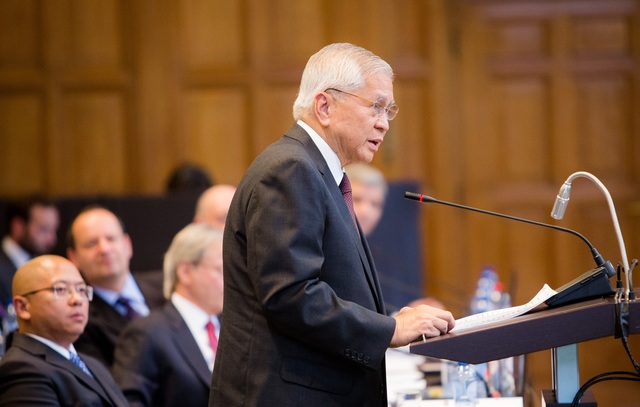
TOP DIPLOMAT. Philippine Foreign Secretary Albert del Rosario delivers an opening statement. Photo courtesy of PCA
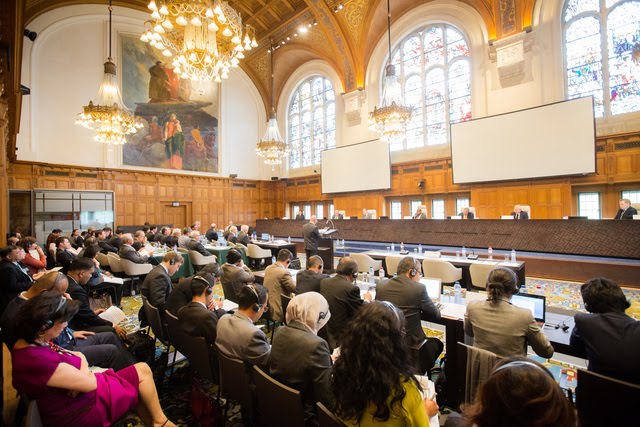
IN SESSION. Early on, the arbitral tribunal in The Hague decides to hold the hearings behind closed doors. Photo courtesy of PCA

TOP GOVERNMENT LAWYER. Philippine Solicitor General Florin Hilbay, who serves as agent for his country, delivers a statement. Photo courtesy of PCA
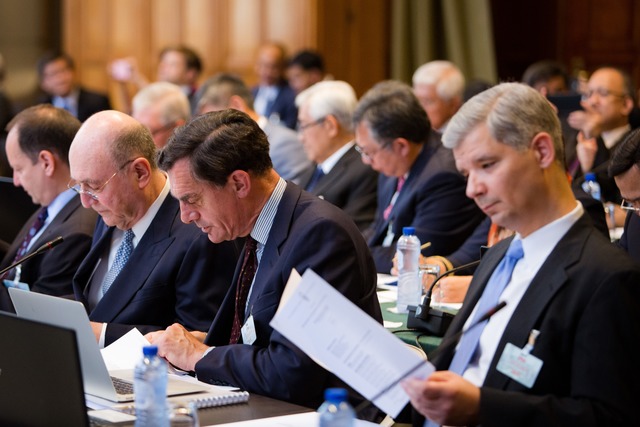
TEAM OF EXPERTS. The counsel team for the Philippines, including Professor Bernard Oxman, Professor Alan Boyle, and Mr Lawrence Martin, in the closed-door hearings. Photo courtesy of PCA
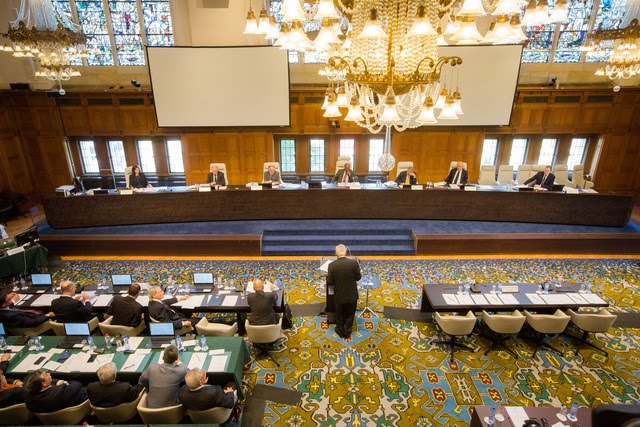
HISTORIC CASE. The arbitral tribunal in The Hague, Netherlands, listens to the first country that brought China to court over the West Philippine Sea (South China Sea). Photo courtesy of PCA
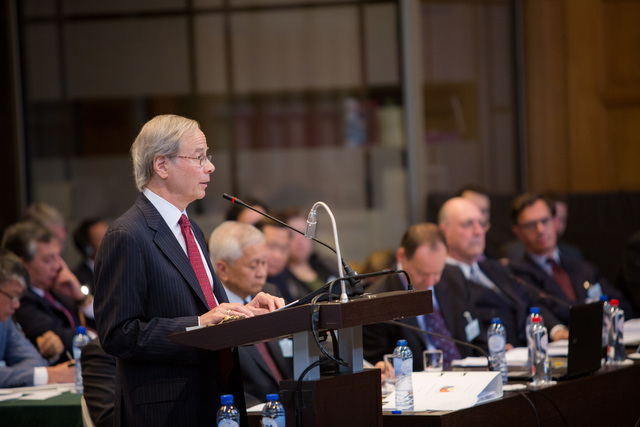
'GIANT SLAYER.' Internationally acclaimed lawyer Paul Reichler, the Philippines' chief counsel, delivers a statement. Photo courtesy of PCA
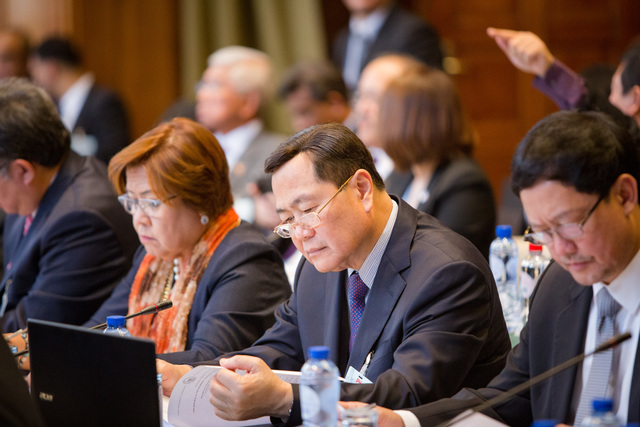
REPRESENTING GOVERNMENT. Members of the Philippine delegation, including Justice Secretary Leila de Lima, Supreme Court Senior Associate Justice Antonio Carpio, and Deputy Executive Secretary for Legal Affairs Menardo Guevarra. Photo courtesy of PCA
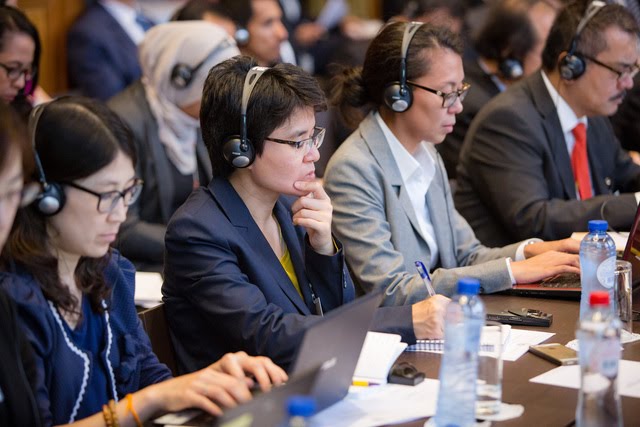
OBSERVER DELEGATIONS. The tribunal allowed observers from the following countries – Vietnam, Malaysia, Indonesia, Thailand, and Japan – to attend the hearings. Photo courtesy of PCA
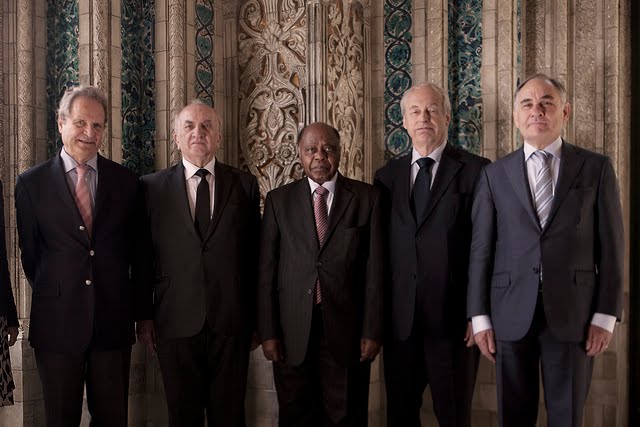
HIGH-CALIBER TRIBUNAL. The arbitral tribunal is led by Judge Thomas Mensah (president, C), the first president of the International Tribunal for the Law of the Sea. The high-caliber tribunal also includes the following (L to R): Judge Jean-Pierre Cot, Judge Stanislaw Pawlak, Judge Rüdiger Wolfrum, and Professor Alfred H. A. Soons. Photo courtesy of PCA
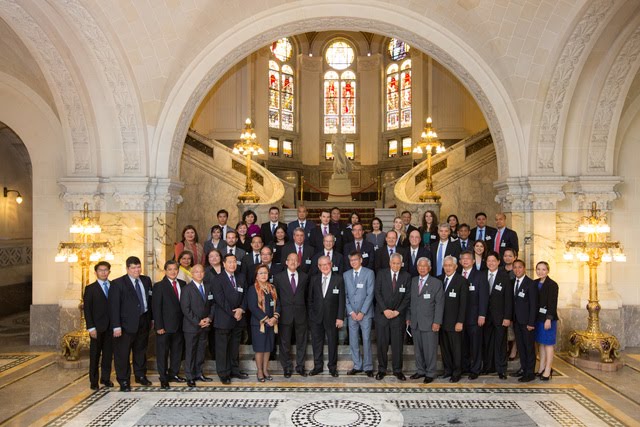
TEAM PHILIPPINES. Representing all 3 branches of Philippine government, the Philippine delegation comes in full force in The Hague. Photo courtesy of PCA
The 5-member tribunal said it "now enters its deliberations" on whether it has the right to hear the Philippines' case. It said it expects to rule on this matter "before the end of the year."
The tribunal said it "is conscious of its duty under the Rules of Procedure to conduct proceedings 'to avoid unnecessary delay and expense and to provide a fair and efficient process.'"
Once the tribunal decides it has jurisdiction over the case, the Philippines can already present the meat of its arguments. (READ: EXPLAINER: Philippines' 5 arguments vs China)
The Philippines said it expects a definitive ruling against China by 2016 – Rappler.com
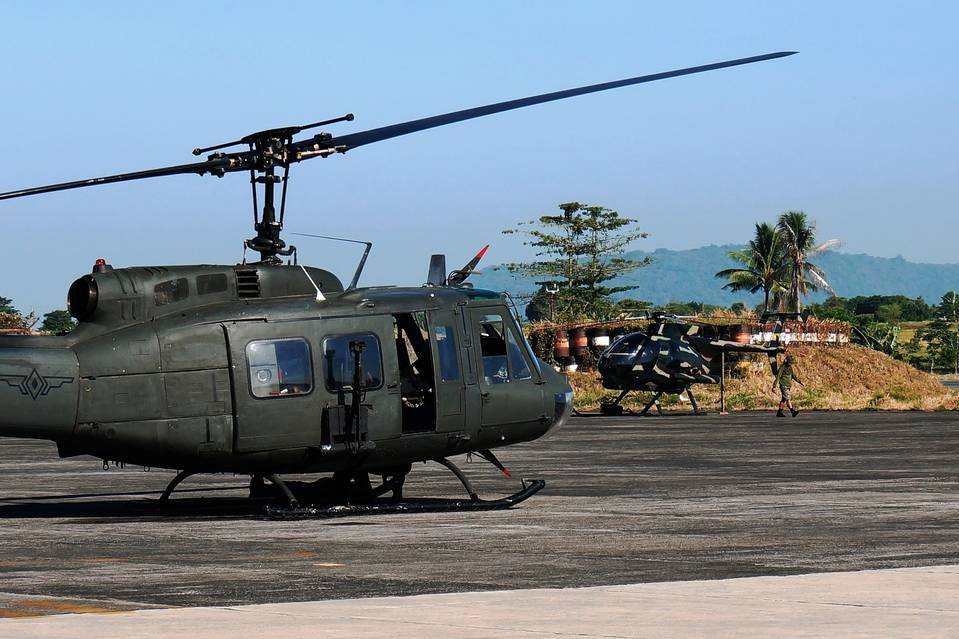
The Philippines relies on aging helicopters such as this UH-1 Huey seen on a recent mission in Mindanao. PHOTO: TREFOR MOSS/THE WALL STREET JOURNAL
Philippine Military Upgrade Stalls
Delay for $1 billion in defense deals leaves planned overhaul years from completion
MANILA—A push by the Philippines to overhaul its obsolete military has ground to a halt just as the U.S. ally is striving to deter China in the disputed waters between them.
A string of programs collectively valued at $1 billion stalled early last year, said military officials and executives involved in Philippine defense deals. The delay underscores how the government’s efforts to transform the country’s derelict navy and air force have become mired in red tape, funding problems and corruption allegations.
The delays leave long-held plans to build a “minimum credible deterrent”—comprising small but capable air and naval fleets—at least a decade from completion, said Jose Antonio Custodio, a Manila-based defense consultant. Even with a basic deterrent in place today, Manila would likely still lack the means to check Beijing’s assertiveness.
“We’re still at square one,” said Mr. Custodio. “With China building all these new bases [in the South China Sea], I’d say it’s already too late.”
Securing secondhand equipment from allies such as Japan and the U.S. may now be the Philippines’ only chance of quickly upgrading its forces, people familiar with the country’s procurement process said. The approach of presidential elections in May make it unlikely that any big contracts will be signed before then.
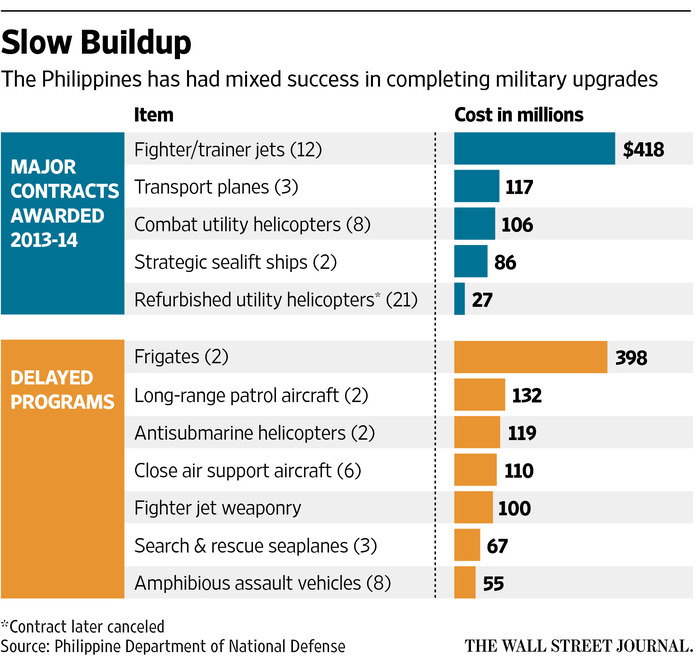
President Benigno Aquino III has promised to rejuvenate the military, which has been degraded by decades of underinvestment.
A pledge to spend $1.7 billion on new equipment initially bore fruit, as the administration signed a flurry of defense contracts valued at $834 million in late 2013 and early 2014, including deals for 12 Korean fighter jets, three Airbus transport planes and a new fleet of combat helicopters from Canada and the U.K.
“The record will show that the Aquino administration has stepped up the pace of [military modernization] considerably, surpassing the procurement program undertaken by three previous administrations combined,” said presidential spokesman Herminio Coloma.
However, Mr. Coloma said Mr. Aquino still hasn’t signed a law passed by the Philippines Congress in February 2013 earmarking $2 billion for defense procurement. Mr. Coloma didn’t explain the delay.
Government finances have been stretched thin after the government spent billions on reconstruction following Supertyphoon Haiyan (Yolanda) in 2013. Spending has also slowed after a recent scandal in which prosecutors charged three senators with corruption for their alleged involvement in the use of dummy NGOs to steal around $220 million in public money. All three senators denied the charges. Strict government procurement rules have been further tightened since then, putting the brakes on a range of spending programs.
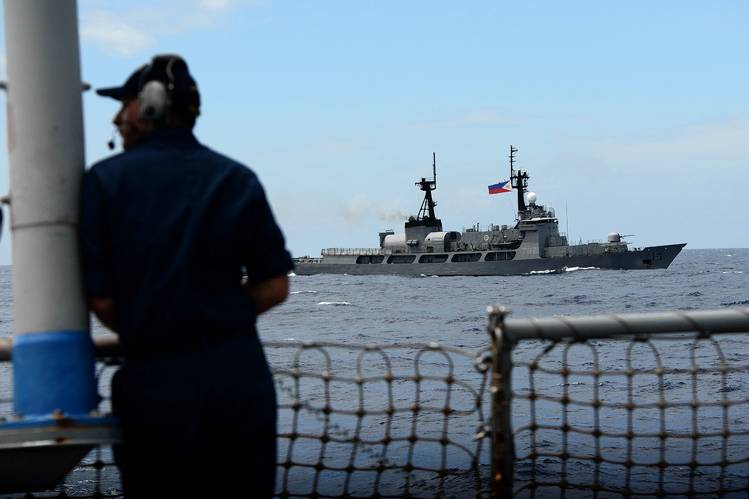
The Philippine vessel Ramon Alcaraz participated in bilateral maritime exercise with the U.S. in June last year.PHOTO: AFP/GETTY IMAGES
Contracts for two naval frigates valued at $398 million and for two long-range patrol planes valued at $132 million—capabilities that would help the Philippines monitor its maritime territory, where it has overlapping claims with China—are among those that were scheduled to have been bid out last year but haven’t moved ahead. “It’s a bureaucratic logjam,” said Mr. Custodio.
Foreign defense companies seeking to supply these and other systems can only wait for the logjam to clear.
“It seems that all programs are paralyzed,” said a Western defense executive whose company is involved in one stalled project.
Another Western executive said the Philippines was hardly unique in experiencing lengthy holdups for military equipment, but recalled how the country’s defense leadership had built momentum in 2013, only to hit the buffers in early 2014.
“Defense officials just don’t have the authority to make things happen now,” he said.
The Philippine Department of National Defense and the Armed Forces of the Philippines didn’t respond to requests to comment.
With China accelerating its island-building program in the South China Sea, Philippine military chief Gen. Gregorio Pio Catapang recently urged Manila to spend more on defense as the country’s economy enjoys healthy growth. Last year’s defense budget was just $3.3 billion—far less than neighboring Singapore’s $9.5 billion.
A Philippines senate inquiry into the country’s military modernization efforts has meanwhile questioned the effectiveness of the funds spent so far, with one senator arguing there was practically nothing to show for the $1.4 billion spent on new weaponry in the decade to 2013.
Senators also looked into a deal for 21 secondhand helicopters, which the defense department canceled in April after only seven deliveries amid concerns about the quality of the technology, and with a Philippine tax official claiming that the aircraft had been ordered in exchange for kickbacks.
The defense department has denied the allegations.
The breakdown of the helicopter program has made defense officials even more reluctant to place new orders and expose themselves to further scrutiny, said Mr. Custodio.
Mr. Aquino has turned to allies for help. On a recent state visit to Japan, he requested secondhand P-3C Orion maritime patrol aircraft, having already received a $183 million loan from Tokyo to fund the construction of 10 new patrol boats. Tokyo has said it is considering the requests, though it hasn’t committed to anything specific. Australia, South Korea and the U.S. have all donated used military kit to Manila in recent years and have signaled a willingness to do more.
But hand-me-downs won’t deliver a deterrent capable of influencing decision makers in Beijing, Mr. Custodio says. “The Chinese are building islands on our doorstep.” - THE WALL STREET JOURNAL: Write to Trefor Moss at trefor.moss@wsj.com
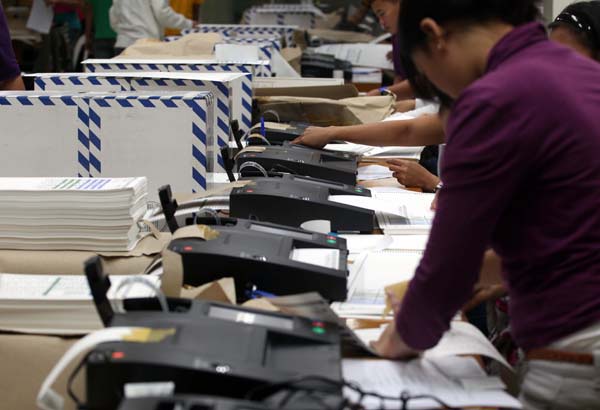
In Resolution No. 2015-004, the Comelec Special Bids and Awards Committee -1 has recommended the issuance of the "Notice of Award" to Smartmatic-Total Information Management for its bid offer of more than ₱1.7 billion Php. photo: PhilStar
Smartmatic bags ₱1.7-B voting machine contract
MANILA, Philippines - The Commission on Elections (Comelec) has approved the awarding to Smartmatic-Total Information Management (TIM) of the contract to lease 23,000 optical mark reader (OMR) machines for the 2016 polls.
In Resolution No. 2015-004, the Comelec Special Bids and Awards Committee -1 (SBAC-1) has recommended the issuance of the "Notice of Award" to the joint venture for its bid offer of more than P1.7 billion.
"SBAC-1 resolves to recommend to the head of the procuring entity the issuance of the Notice of Award (to the joint venture) as the bidder with the lowest calculated responsive bid for the lease with option to purchase of election management system and precinct-based OMR or optical scan system," the committee said.
The project has an approved budget of ₱2.5 billion Php, but Smartmatic-TIM's bid offer was only ₱1.72 billion Php.
SBAC-1 had disqualified Smartmatic-TIM twice after it found the joint venture's bid documents to be "non-responsive" they did not contain Articles of Incorporation and actual bid price offer. The Comelec approved the joint venture's appeal for reconsideration.
The Comelec also declared a failure the joint venture's demonstration of its machines during the post qualification stage of the bidding. But when the joint venture protested, the poll body relented.
SBAC-1 added in its resolution that Smartmatic-TIM is required to "post its corresponding performance security in an amount equal to a percentage of the total contract price."
Currently, the Comelec is looking at two options for the conduct of polls next year.
One option is to refurbish some 81,000 precinct count optical scan (PCOS) machines, while the other option is to lease 70,000 more OMR machines.
The 23,000 OMR machines will supplement whichever of the two options is chosen.
Meanwhile, Comelec Chairman Andres Bautista met with officials and members of the Catholic Bishops' Conference of the Philippines (CBCP) last Sunday to brief them on what to expect from a computerized conduct of polls in 2016.
CBCP president Lingayen-Dagupan Arcbishop Socrates Villegas said the meeting coincided with the 111th Plenary Assembly of bishops.
Villegas said the prelates would further tackle election issues in the next plenary assembly in January. While the CBCP did not issue post-assembly statement on the elections, Villegas said it's the consensus among the bishops that next year's polls should be transparent, efficient and with public accountability. – Evelyn Macairan :Sheila Crisostomo - Philstar